Have you ever thought about exploring the great outdoors in Alaska in an amazing RV adventure of a lifetime, but had no clue where to start? Or perhaps you have been to Alaska previously on a cruise and would like to do something completely different, but you don’t know the first thing about how to rent an RV. If either of these apply to you, then you’ve come to right place. In this post I will step though all of what is involved in this process, and help ease your decision in considering this choice for a vacation.
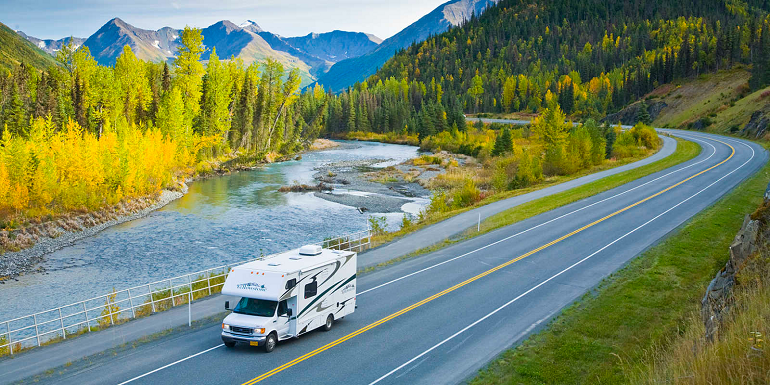
While the below steps may seem a bit overwhelming, trust me it’s really not as difficult as you may think – especially if you have ZERO experience with this. Prior to our first rental we had none as well. Choosing to rent an RV for our trip to Alaska was one of the best decisions we’ve made during our travels, and this remains one of our favorite family vacations to this day!
RV Basics
RV stands for “Recreational Vehicle” and is a term that is used that applies to motorhomes, travel trailers, and similar type equipment used for recreational purposes. However when most people refer to RVs, they are referring to motorhomes. The difference between a motorhome and a travel trailer is that one is driven and the other is pulled by a truck or other large vehicle. In this post I will only discuss drive-able RVs (motorhomes).
Types of RVs
There are three different types of RVs. Below is a simple and quick guide to the difference between the types.
Class A
These are the largest and most expensive class of motorhomes. These RVs usually resemble buses. They can extend up to 40 feet long, and accommodate between five to seven passengers, and offer the largest selection of amenities. They’re like having a mini house on wheels. They usually include a bathroom, kitchen, living room, bedroom, and much more. (Typical rental rate: $100-$300 per night)
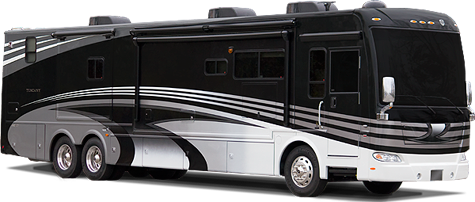 Class B
Class B
These are the smallest and least expensive class of motorhomes. These RVs are similar to large vans and are typically around fifteen feet long. Class B RVs fit two passengers comfortably, but could sleep up to 4 people. Their amenities are usually very limited but are good for a beginner who doesn’t want to handle anything too large. (Typical rental rate: $50-$75 per night)
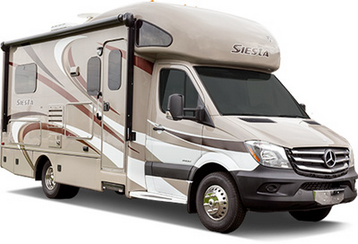 Class C
Class C
These are the standard or middle-sized RVs. They can vary in length but they’re quite a bit larger than the Class B RVs usually measuring about 30 feet in length. The Class C RV fits five people comfortably, but can hold up to seven in larger models. They offer a wide selection of amenities such as a small living space, dinette table, mini kitchen, bathroom, and beds. Class C RVs are perfect for families. (Typical rental rate: $100-$200 per night)
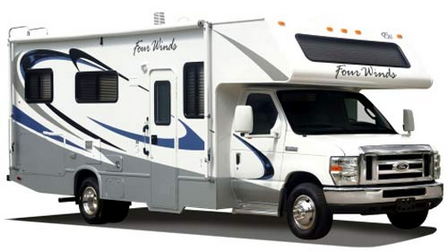
Our family rented a Winnebago 24P Class C RV. This was 24 feet long and slept 6 people. It wasn’t too large or too small, and it was perfect for our needs. Below is the floor-plan for the model we rented and a picture of our family with our rental in Alaska.
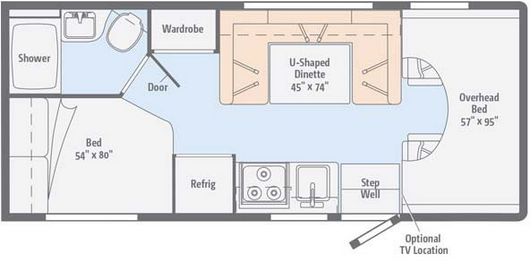

Your rental company website will have detailed photos, floor-plans, and more to help you choose which you think would be the best for your needs.
Choosing an RV Rental Company
There are many RV companies in Alaska to choose from to rent an RV. Most of these are based in Anchorage, and is where we started our trip. Below is a list of many of them that link to their individual websites. While this list doesn’t constitute all the choices, it includes the most popular companies in the Anchorage area. Be sure to read the reviews from past renters before making your final decision.
- ABC Motorhome & Car Rentals
- Alaska Adventure Car & Camper Van Rental
- Alaska Best RV Rentals
- Alaska Family Motorhomes
- Alaska Grizzly RV Rentals
- Alaska Wilderness RV
- A&M RV Center
- Clippership Motorhome Rentals
- Cruise America
- Explore Alaska
- Great Alaskan Holidays, Inc.
- RVShare
While most of the above companies are similar to each other in how they function, RVShare is a little different. RVShare is a community driven RV rental marketplace comprised of independent dealers and private owners. In simple terms, RVShare provides a way to for individual RV owners rent out their own personal RVs to families looking to rent an RV for a short time, and learn about RVing. Renting with a peer-to-peer site like RVShare is beneficial for a few reasons. It cuts out the middleman and a competitive marketplace, meaning renters can get the best possible rates. Renters also have access to a diverse inventory, allowing them to choose from many different sizes and styles of RV. Working directly with owners has additional benefits because they know every detail about their RV better than anyone and will provide an exceptional orientation and great service. Renters can expect an RV that is well taken care of, and total transparency – all fees are disclosed right up front. RVShare is also partnered with the most experienced RV rental insurance company in the world to provide all the necessary coverage.
Who is Driving?
One important thing to keep in mind when you chose to rent an RV is who will be driving it? While only a regular standard drivers license is required to rent and drive an RV, most companies will require the driver to be at least 21 years of age. Some require you to be at least 25 years of age. If you plan to have multiple drivers, each driver will have to meet these same requirements and declared at the time of rental. Some companies may charge a fee for additional drivers so this is something you should check with your rental company.
Rental Deposits
There are two types of deposits you will likely be required to make when you rent an RV. The first is the initial deposit when you first make the reservation. This deposit is usually in the ballpark of $300-$500, however every company sets their own rates. This deposit simple secures your reservation and will either be refunded to you or applied to your total rental amount.
The second type of deposit you will be responsible for is the security deposit, and is usually standard with every rental company. This usually ranges from $500-$1000 which is 100% refundable once you return the RV free of damage.
Rental Insurance
This one is paramount and one that you should definitely consider when you decide to rent an RV. Unlike renting a car, RVs are a different animal and may not be covered by your standard auto insurance or credit card. If the rental company doesn’t initially mention it when securing your rental, ask if additional insurance is offered by them. Many will offer it and will inform you about all the details prior to your rental. If they don’t offer it, you will be required to make sure you are fully insured prior to renting the RV. You may be covered already under your current auto insurance, but it’s very likely you will not be, and need to take out additional insurance to cover the RV. Be sure you FULLY understand what is covered and not covered by the policy you agree upon. This can save you many possible headaches down the road in the event of an unforeseen event.
The company we went with included free liability insurance as part of their service, but we chose to take out additional insurance to significantly lower the cost of collision and comprehensive deductibles just in case. While we ended up not needing it, this gave us peace of mind.
RV Rental Rates
When you rent an RV, it’s easy to get overwhelmed because prices can fluctuate greatly. The rate depends on many things, such as vehicle type (discussed above), rental length, distance traveled, season, availability, and others. It’s a good idea to think of it like renting a hotel room. The larger more elaborate hotel room you choose, the more you’ll likely pay. Same goes for an RV. You can usually score much better deals by reserving as early as possible, especially with larger companies who often run specials and promotions. We booked ours in November of 2013 for a June 2014 rental and were able to get a great early bird discount!
Price Per Mile
Some RV companies will charge you per mile driven. The average rate is between $0.30 and $0.50 per mile. This can add up quickly especially if you plan to drive a long way around the state like we did. I would suggest carefully adding up the distance for your trip in advance, or simply inquire about a rental with unlimited miles. Some companies may charge an extra fee for unlimited miles (typically sold for about $20 per day), while some will just include the option in the rental as part of the price. Our rental had included unlimited mileage which was very nice to not have to worry about.
Additional Expenses
Fuel
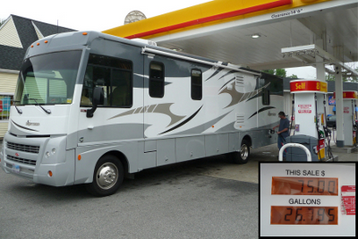 This is one obvious thing you’ll need when you rent an RV, but is often overlooked when configuring the cost of your adventure. RV gas mileage can range from 7 to 20 MPG (miles per gallon). Be sure to ask about the MPG rating of the RV you chose so you can calculate how much to expect to spend on gas by multiplying it by your estimated number of miles traveled. It’s also a good idea to use an app like Gas Buddy to see what the current gas prices are where you plan to travel. Gas prices in Alaska are usually a bit higher than prices in the lower 48 (area dependent).
This is one obvious thing you’ll need when you rent an RV, but is often overlooked when configuring the cost of your adventure. RV gas mileage can range from 7 to 20 MPG (miles per gallon). Be sure to ask about the MPG rating of the RV you chose so you can calculate how much to expect to spend on gas by multiplying it by your estimated number of miles traveled. It’s also a good idea to use an app like Gas Buddy to see what the current gas prices are where you plan to travel. Gas prices in Alaska are usually a bit higher than prices in the lower 48 (area dependent).
Food
You will need to provide your own food while in your RV so remember to plan for this in your budget. Anchorage has major supermarkets along with a Walmart Super-center where you can purchase food and snacks for your journey.
Supplies
Check with your rental company to find out what all is included in your rental. Most large companies will provide a plethora of essentials such as utensils, pots, pans, plates, etc; however it’s a good idea to verify exactly what comes with the rental and what does not. The company should be able to provide an itemized list of exactly what you are getting. For an additional expense, there are often bonus items you can have added. We paid additional to rent lawn chairs, a toaster, a deluxe barbecue, and firewood.
If you are traveling with small children (as we were), be sure to bring your car seat with you (as I’m unsure if RV rental companies provide them). They can strap in easily in the RV so your kiddies can be safe as they are riding down the road – even while seated at the kitchen table! For additional tips on traveling with a car seat, check out this excellent guide.
What to Pack
While this section doesn’t necessarily help you in renting the RV, many who are going on an adventure like this for the first time may be unsure how to pack for it. Below is a helpful list of items you may want to bring along. The list isn’t an all inclusive mandatory list of items, but some good suggestions to consider.
- Camera
- Binoculars
- Hiking Boots
- Waterproof Boots
- Waterproof Backpack
- “Wicking” Wool Socks
- Rain Gear (Ponchos, waterproof jackets, etc)
- Fishing Gear (pole, line, lures, etc)
- Mosquito Spray/Lotion
- Mosquito/Bug Tent with pop-up setup.
- Sun Screen
- Chapstick
- Bear Spray (this can be purchased online, or locally in Anchorage)
- Survival Gear (knife, emergency blanket, first aid kit, etc)
- Hiking GPS
- Hiking Emergency Beacon and/or Satellite Tracker and Communicator
- GPS enabled smart phone for offline maps.
See bottom of this article for some links to recommended products available for purchase through Amazon.com.
Picking Up Your RV
Once you’re ready to go, picking up your RV is rather simple. The company will provide directions to their facilities for when you land in Anchorage. Be sure to check the RV rental company’s operating hours. If your flight lands after the company has closed for the evening, you will need to find out how the RV company handles this. This was the case with us when we went on our trip. Our RV rental company offered an excellent after-hours pickup service which allowed us to sleep in our RV the night of our arrival!
Your rental company will most likely have an orientation for you to attend which will provide basic instructions on the operation of the RV. Our company showed us a video as well which was very beneficial for the first-time RVer.
Your orientation should include everything you need to know on how to properly operate and maintain your RV. This includes how to fill the potable water tank, empty the waste water tanks, reset breakers, and more.
Choosing Campsites
Alaska has a plethora of choices on where to camp with an RV. You will not have a problem finding a place to stay. The toughest part will be selecting which one you like the best. The rates range from $0 a night (yes, there are some free ones) to over $40 a night. The lower priced ones often will not have any hookups (i.e. electrical, water, sewage), therefore staying at these will require use of your battery and holding tanks. You can read about various different RV parks and campgrounds online to determine in advance what amenities come with the stay. A great site to check out for this is Alaska.org. We mixed up our stays during out 11 night adventure. Some nights staying at campgrounds with no hook-ups, and other nights staying at an RV Park with full hook-ups.
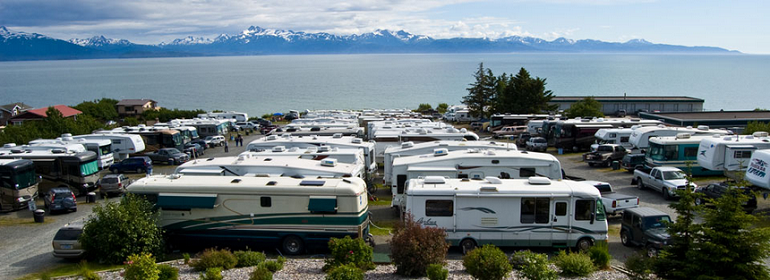
Dump Stations and Potable Water Stations
 While enjoying your RV rental, you will be required every so often to refill your potable water tank, as well as dump your waste water tanks. There are meters inside the RV that let you know how full or empty they are. It’s important to keep an eye on these during your journey to ensure you don’t run out of water along your route, or worse – fill up your waste water tank. The links below provide a list of locations on where to find these in Alaska.
While enjoying your RV rental, you will be required every so often to refill your potable water tank, as well as dump your waste water tanks. There are meters inside the RV that let you know how full or empty they are. It’s important to keep an eye on these during your journey to ensure you don’t run out of water along your route, or worse – fill up your waste water tank. The links below provide a list of locations on where to find these in Alaska.
The MilePost
While not mandatory, this book can be a lifesaver when exploring the highways of Alaska. Published every year, this is the must-have guide to Alaskan roads. Not only is it chock-full of excellent tourist information about every area of Alaska, but it gives a detailed account of what can be found at every exit along Alaskan roads. This is VERY helpful when driving an RV around and you’re looking for a gas station, dump station, or potable water station. It also contains information on campgrounds, RV parks, and much more. We definitely recommend picking up a copy before your journey. You can order it from Amazon by clicking here
or on the image link to the right.
Disclosure: Off with the Kids receives a small commission for any purchase made by clicking on the links on our website. We are truly appreciative if you choose to purchase anything through our site, and sincerely thank you for helping to support our blog!
Returning Your RV
Returning the RV is pretty simple, especially if you take care of it as you’re required and leave it as you were given it – clean and undamaged. If you managed to damage the RV during your trip, or failed to clean it properly, you may be subject to additional fees. Below is a list of the potential fees you may encounter and how you can avoid them.
Late Fee
Verify the day and time that the rental company expects you to return your RV. If you return the vehicle late, then you will be charged a late fee. These fees can be high – typically $25 per hour late! It is also common to be charged for an additional day for bringing the RV back late. It’s good practice to aim to return your RV several hours early, just to be safe.
Holding Tank Fee
RVs usually come equipped with holding tanks that store the waste water from your RV. These tanks will collect dirty sink and shower water (grey water) as well as toilet water (black water). Almost all rental companies will require you to empty these tanks prior to returning your RV. The fee for failing to empty the tank is typically under $100.
Cleaning Fee
This one should be a no-brainer. If you rent an RV, you will be expected to leave it spotless like it will be given to you. This means if you track dirt, mud, or other unpleasantries into the vehicle, be sure to clean it all prior to returning it. Failure to do so will leave you facing a fine of roughly $100.
Damage Fee
This is the one fee we all hope to avoid, as it’s the largest. When driving the RV, take your best care not to damage it in any way. Even if you cause minor damage, you will likely lose your security deposit. This can and will include scratches, so be careful when driving under overhanging tree limbs that may scratch the roof of the vehicle, as this is a common mistake. If you cause major damage to the RV, then you will be forced to pay for anything not covered by your insurance.
That’s all there is to it! Hopefully now you have at least a head start on planning your first Alaskan RV adventure! If there is something I didn’t cover or something you would like more information on, please feel free to comment below and let me know. Otherwise I hope you enjoyed this post. Happy RVing!








This sounds awesome! I’ve always wanted to do an RV trip! I love road trips and driving. This actually sounds like an economical way to travel, I thought it would cost more!
Very nice article. I really enjoyed the thoroughness of your reporting.
Renting an RV is a great way to see the great state of Alaska, where every stop is a scenic stop.
When you travel with children in an RV, the refrigerator, stove, toilet, DVD player and bed travel with you, so the journey is more pleasurable and relaxed for all.
One thing I would like to add is the fact that many RV rentals, campgrounds, day cruises, charter boats and even Denali buses (once parked, you must take a tour bus to travel around Denali national park) will sell out months prior to your trip. So I always recommend that you get plane tickets and motorhome RV reservations along with select campgrounds and other key side trips reserved as soon as practical.
Excellent points Tom. Thank you so much for your comment! 🙂
Excellent article for the traveler planning an RV trip to Alaska! You just missed one more great rental option! 🙂
Hey there! Thanks for the comment! I revised the post to include Alaska Wilderness RV! 😀
I never thought to rent an camper. my parents gave a class A one and it’s nice!
Good step by step description. My neighbors are headed out for an Alaska trip in the spring – I will forward to them. I will also post a link on my Travel Directory Blog.
Thank you so much for the comment! 🙂
We’ve tossed around the idea of renting a trailer for a trip (instead of an RV since my husband drives a truck), but we’ve not gotten around to it yet. It sounds like you had a wonderful time!
Yes we did. My wife still considers this her favorite vacation. 🙂
Renting an RV for a trip north will cost a pretty penny, but its well worth the expense to check this destination off your bucket list. Be prepared for sticker shock!